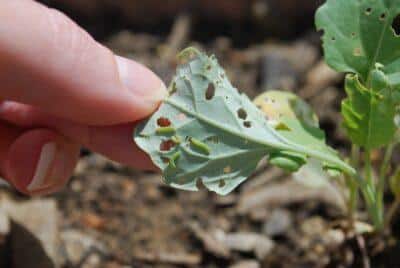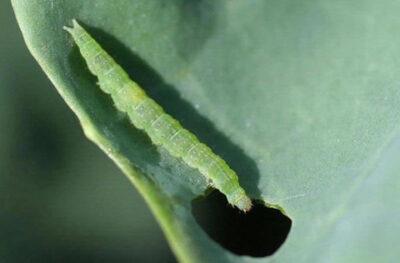Imagine planting your kale and broccoli as seeds, watering them and watching them grow. You lovingly care for them until one day, to your horror, you notice holes in the leaves and branches that are striped. What evil was let loose on your fresh produce dream?
There are several types of kale and broccoli-loving bugs and insects, more often being caterpillars. Let’s take a look at these veggie-eating critters and discover what we can do about them.
Cabbage White Butterfly
The Pieris Rapae or cabbage white butterfly has caterpillars which are green with a light yellow stripe down the middle of the back and have a velvety texture. They like to eat close to the center of the plant. The adults have white wings with black tips. The females have two black spots on the wings, while the males have one. Another name for this type of caterpillar is the imported cabbage worm. By whatever name you wish to call it, this type of butterfly can manage generations in only one season.
Cabbage Looper
This butterfly also goes by the name Trichoplusia ni. Adults are molted brown and white and are mostly active during nighttime or dusk. These guys LOVE kale and since they are leaf-eaters, they will stripe the plant bare. The caterpillars have a rather smooth look, being a dusty white color at first and then become green with white stripes on the sides when they start eating the plants. They can be green or brown on their thorax area. These caterpillars cannot handle cold temperatures at all.
Diamondback Moth
Plutella Xylostella love young plant buds and do the most damage to the vegetable plants during the larval stage. The caterpillars are a pale green or yellowish green with hairs at the beginning.
Want The Best Chemical-Free, All-Natural Insecticide — For Your Garden
They eventually smooth out in appearance and have a forked hind end. They love to feed on all plants, including kale and broccoli. Caterpillars of this type burrow into the leaves and eat from the inside out. Adults have yellow, wave-like markings that form diamonds on their backs when at rest. Diamondback butterflies can have up to four generations a year.
Cross-striped Cabbage Worms
These caterpillars love fresh, young buds on seedlings. The caterpillars are a bluish grey color, with cross-wise black stripes, and a yellow and black stripe that runs along the long part of the body. Adults are light brownish gray, with darker gray splotches. This particular insect is known to love kale and collard greens.
What Can We Do?
1. Sprays
All caterpillars can be controlled by Dipel or Thuricide, also called Bacillus thuringiensis (BT.). Pyrethroids are also successful in ridding these pests from your kale and broccoli, but they are mostly, if not all, synthetic, so they’re not for use in an organic-only garden. Natural pyrethrum or pyrethrin is allowed. You can spray BT or BTK (Bacillus Thuringiensis var. Kurstaki) every one to two weeks. The same pattern should be followed with Sevin. Neem can also get rid of caterpillars.
An organic spray, easy to make, is a mixture of water and detergent. You can spray this after hand picking the plants.
2. Traps
Black light traps or pheromone traps are successful in helping to catch moths and butterflies. These two kinds of traps are often used together. Since butterflies and moths use smell to locate food, the traps draw them away from your garden and to the trap. You can even use those sticky, yellow bug traps, but remember they will also catch and kill insects that benefit the garden.
3. Predators
Predators like wasps can help keep the caterpillars under control. There are non-human-stinging wasps named Trichogramma wasps that are beneficial to ridding the garden from caterpillars. They are tiny wasps, and they destroy the eggs and caterpillars of any butterfly and moth.
The Cheap Way To Re-mineralize Your Soil
You can even get them by mail order! You will also need to keep your garden tidy and clean. Keep it clear of weeds or any flowering plant besides your vegetables.
4. Covering plants
You can place row covers over your kale and broccoli, as they grow to prevent any moth or butterfly from landing in the first place. If they can’t land on the plants, they won’t be able to lay their eggs there.
5. Hand Picking
You can spend some time hand picking the pests from your plants. This is the most effective method, but also the most time consuming. Caterpillars are sticky little buggers, but once picked off, you can either squish them or drop them into a bucket of soapy water. They will be very well hidden, so look carefully. Look on both the top and underneath of each leaf. They will range in size due to maturity level. Rinse the plants afterward to remove any caterpillar excrement.
6. Household Foods
You can sprinkle cornmeal around and on your kale and broccoli. This will cause the caterpillars to swell up and die after ingesting (the cornmeal.) You can also spread crushed eggshells around the plants. This has been effective in deterring caterpillars from approaching the plants.
7. Herbs
You can plant a variety of herbs that have strong fragrances, smells or perfumes. Lavender is especially effective. The smell disguises the delicious (to butterflies and moths) smell of kale and broccoli. As mentioned before, if the butterflies can’t smell your crops, they won’t be laying eggs there. White clover also seems to be effective when planted among vegetables.
How do you control insects on your kale and broccoli? Share your tips in the section below:
Get Rid Of Garden Pests The All-Natural Way. Read More Here.
 Off The Grid News Better Ideas For Off The Grid Living
Off The Grid News Better Ideas For Off The Grid Living





